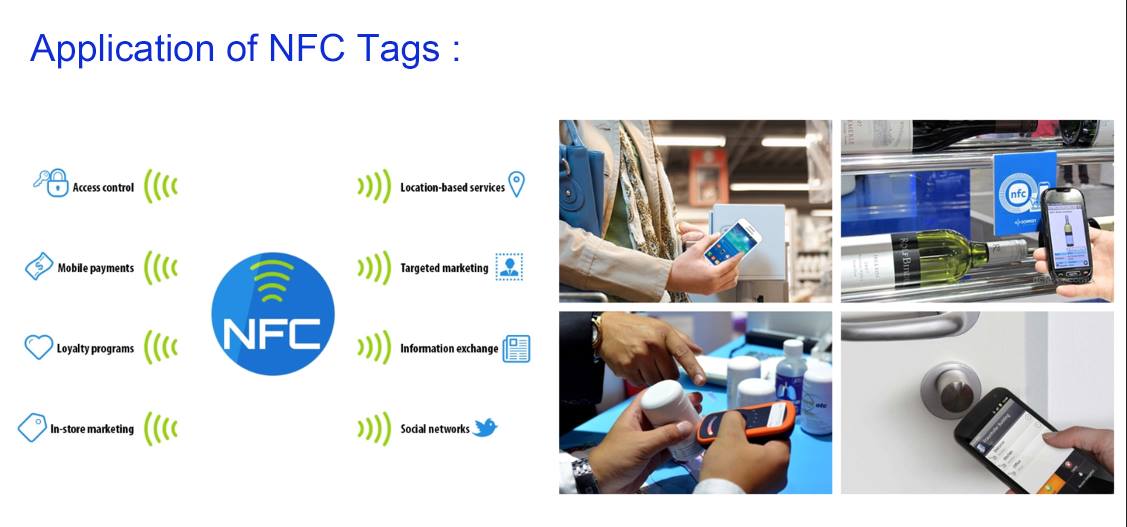Nowadays, NFC technology is very common and has its function in most high-end smartphones. In addition to phone-to-phone communication, small NFC tags can also be used to store and transmit information. You may have noticed advertisements near bus stops, small NFC tags next to store stickers, or may even come across the clever idea of using NFC-enabled business cards.
These tags can store a wide range of information, from short lines of text (such as URLs or contact details) to links to apps in the Google Play store. This is a fast and effective way to quickly push information to mobile phones. These small tags can replace bar codes and QI codes, and in some cases can even replace Bluetooth. So this is how it works.
How does this work
NFC tags are passive devices, which means they operate without their own power source and rely on active devices to enter range before being activated. The trade-off here is that these devices cannot really do any processing, they are only used to transmit information to active devices, such as smart phones.
To power these NFC tags, electromagnetic induction is used to generate current in passive devices. We will not be too professional in this area, but the basic principle is that a coil can be used to generate electromagnetic waves, which can then be picked up by another coil and converted back into electric current. This is very similar to the technology used for wireless charging technology, although the functionality is much weaker.
What is NFC and how does it work
Active devices (such as your smartphone) are responsible for generating the magnetic field. This is done with a simple coil, which generates a magnetic field perpendicular to the flow of alternating current in the wire. The strength of the magnetic field can be adjusted by changing the number of turns of the coil or increasing the current flowing through the wire. However, larger currents obviously require more energy, and very high power requirements are not advisable for the use of battery-powered mobile technology. Therefore, why the working distance of NFC is only a few inches instead of the many meters that we are accustomed to using other types of wireless communication.
Here you can see the induction coil and the microchip on the back of the NFC tag.
Passive devices work in the same way, but in reverse. Once the passive device is within the magnetic field of the active device, the electrons in the wire receiving coil will start to generate a current that matches the current in the transmitting smartphone. There will always be some power loss during transmission through the air, but the current generated over a short distance is sufficient to power the circuit in the NFC tag.
These circuits are fine-tuned to a certain frequency, thereby increasing the device's sensitivity to the charging frequency. This allows maximum energy transfer through the air. Once the tag is powered on, it can synchronize and send data at 106, 212, or 424 Kbps through the 13.56MHz NFC transmission frequency, just like regular NFC communication between mobile phones or other large devices.
Different label types
NFC tags use ISO 14443 Type A and Type B wireless standards for communication, which is an international standard for contactless smart cards used in many public transportation systems. This is why NFC devices can be used with existing contactless technologies such as card payment points.
There are a range of different tag types available, each of which provides different storage levels and transmission speeds. Tag types 1 and 2 have a capacity between 48 bytes and 2 kilobytes of data, and can transmit this information at only 106 kbit/s. Although this may sound small, especially when compared to a typical SD card, this data is sufficient for some very simple information (such as website URLs) and is all that most basic NFC tags require data. The design of these labels is cost-effective, and if you want to change the data stored in them, you can also reuse them.
As consumers start to use Android, Apple and Samsung Pay, NFC payment terminals are becoming more and more common.
Type 3 uses a different Sony Felica standard and can transmit data at a slightly faster 212 kbit/s. These are often used for more complex applications, but unfortunately cannot be rewritten. Similarly, Type 4 is also read-only, but has a larger memory capacity of up to 32 KB and a communication speed between 106 kbit/s and a maximum NFC of 424 kbit/s. Tag type 4 applies to types A and B of the ISO14443 standard.
Cheap and effective
Compared with other forms of short-distance wireless communication, the strongest argument for supporting NFC is that the manufacturing and maintenance costs of tags are very low, but they can still be used for a wide range of applications. With very simple circuits and few components, NFC tags can be mass-produced at a very low unit cost.
Combine low cost with no power requirements, and you have a cheap and effective way to communicate quickly with other smart devices. From launching apps to exchanging websites and buying train tickets, NFC aims to make our lives more convenient by using our smartphones.
In view of the introduction of mobile payment methods that can use NFC, more and more smart phones are beginning to support NFC communication. Don’t be surprised if you see more and more of these small tags everywhere.
Buy NFC tags
If you want to pick some cheap labels for an item or just to make trouble, there are usually some very good deals on SunRise Security.
